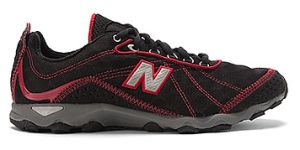
With a minimal, thoughtfully-designed upper constructed entirely out of fabric made from post-consumer plastic bottles, newSKY represents an innovative approach to both material and shoe design as part of a greater effort from New Balance to adopt more sustainable practices. To learn more about the shoe’s development, we sat down with New Balance Senior Designer Christine Hall and Design Lead for Wellness Drew Spieth to discuss how they used recycled material to create a comfortable, stylish shoe.
“The principles of shoemaking didn’t necessarily apply to this fabric,” said Drew. “It doesn’t work like a regular shoe material.” To accommodate the fabric’s unique characteristics, the designers decided to reduce the amount of extraneous elements, including only what’s necessary and leaving out what’s not – a purposeful approach to shoe design that New Balance continues to implement through footwear collections such as the NB Minimus. In the development of newSKY, the designers borrowed elements from NB Minimus by utilizing the same outsole and last. “For the design intent of the upper, the same philosophies are applied – minimizing the amount of materials used so you’re not over-building the shoe, but making it as comfortable as possible,” said Drew.
The decision to use recycled fabric for the entire upper was one of the biggest hurdles to overcome, as well as the greatest opportunity for innovation. “A typical shoe has a lot of different types of materials,” said Drew. “What’s really interesting about this is, aside from the foam and the little rubber components [on the outsole] and a little bit of water based glue, the only material here is the recycled fabric.”
The designers were confronted with the challenge of replacing traditional elements of shoe construction such as foam, leather, or plastic with the recycled material – all while maintaining both comfort and durability. ”With every piece of the shoe we were challenged to go back to our old standbys for a lot of materials,” said Drew.

In traditional shoe design, materials like plastic and leather provide shape and structure; however, the designers reduced the need for conventional reinforcements. Typically, a rigid counter would be used to support the heel, but here, the heel has been reinforced with strategic stitching along the back seam combined with a thicker weight of fabric. “The heel is where most of the reinforcing happens,” said Christine. “But when we doubled-up the material you don’t need any reinforcement because the material is doing it itself.”
By working with the fabric’s distinctive features, the designers eliminated the need for many traditional, non-recycled materials. For a typical shoe, “there’s foam, a reinforcer, another reinforcer, and an external material,” said Drew. “A lot of stuff goes in there and we stripped all that out.”

To learn more about how the fabric moved, flexed, and held up under different construction methods, the designers experimented with the shoe’s assembly. In early prototypes, the material was molded to see how it would react – the fabric was cut into one piece, heated, and then pressed to form the shape of the shoe. “As you mold it, the material becomes very rigid, so it has a really interesting look to it, but it’s kind of hard.” said Christine. “In our own design ethos, one of the things we talk about a lot is comfort and something that feels really nice and soft.” The decision was made to revert to a more traditional stitching technique – allowing the recycled material to be soft, pliable, but most importantly, very comfortable on the foot.
In the final design, each element of newSKY is a testament to thoughtful shoe construction through an innovative use of material. Fabric made from post-consumer plastic bottles was developed into a comfortable, well-designed shoe. “It was a big goal to keep it functional and looking stylish,” said Drew. “At the end of the day, it looks like an interesting shoe and also looks great on the foot.”

 Anton Krupicka running on a Sports Research Lab treadmill: TenBroek: “We set up to capture motion capture data on his gait. Kyle Skaggs is awaiting his turn in the background also. We can capture how these guys move in a typical product and then see how they move in something like the NB Minimus.”
Anton Krupicka running on a Sports Research Lab treadmill: TenBroek: “We set up to capture motion capture data on his gait. Kyle Skaggs is awaiting his turn in the background also. We can capture how these guys move in a typical product and then see how they move in something like the NB Minimus.”
 Drop: ‘Drop’ is the difference between heel height and toe height. All NB Minimus shoes have a 4mm drop which provides a more neutral foot position than traditional shoes (which average a 12mm drop).
Drop: ‘Drop’ is the difference between heel height and toe height. All NB Minimus shoes have a 4mm drop which provides a more neutral foot position than traditional shoes (which average a 12mm drop). What loading rates look like: The data from the in-shoe pressure system used in the New Balance Sports Research Lab can be converted to three dimensional animations of the runner’s strike, illustrating the impact on the runner’s foot through the stride.
What loading rates look like: The data from the in-shoe pressure system used in the New Balance Sports Research Lab can be converted to three dimensional animations of the runner’s strike, illustrating the impact on the runner’s foot through the stride. The force plate: A glass plate mounted on a concrete and steel structure and made with piezoelectric crystals, measures a runner’s force in three directions: left-to-right, forward-to-back, and vertically.
The force plate: A glass plate mounted on a concrete and steel structure and made with piezoelectric crystals, measures a runner’s force in three directions: left-to-right, forward-to-back, and vertically.


















